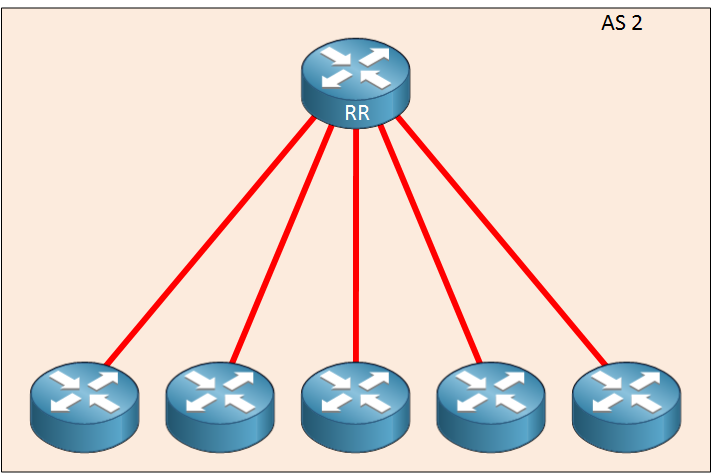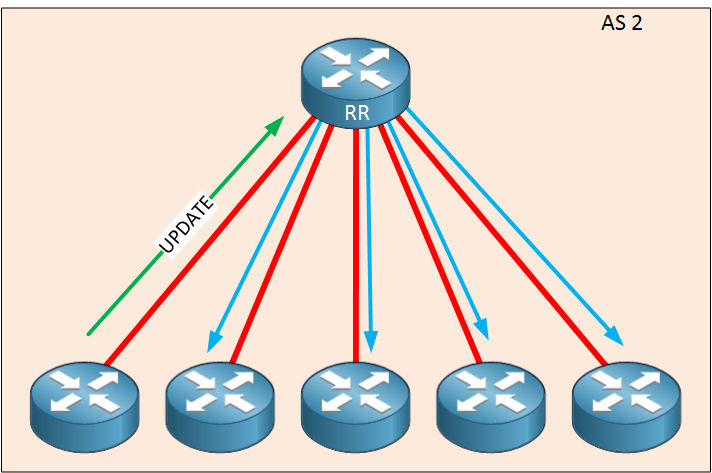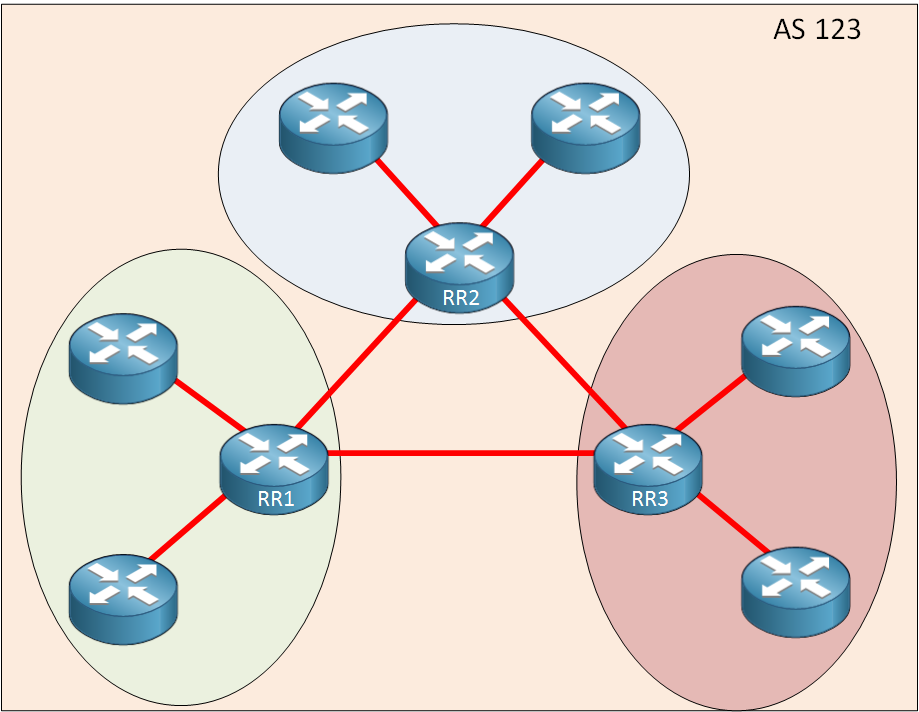Route reflectors (RR) are one method to get rid of the full-mesh of IBGP peers in your network. The other method is BGP confederations.
The route reflector allows all IBGP speakers within your autonomous network to learn about the available routes without introducing loops. Let me show you an example picture:

Above we have a network with 6 IBGP routers. Using the full mesh formula we can calculate the number of IBGP peerings:
N(N-1)/2
So that will be:
6(6-1=5) / 2 = 15 IBGP peerings.
When we use a route reflector our network could look like this:

We still have 6 routers but each router only has an IBGP peering with the route reflector on top. When one of those IBGP routes advertises a route to the route reflector, it will be “reflected” to all other IBGP routers:

This simplifies our IBGP configuration a lot but there’s also a downside. What if the route reflector crashes? It’s a single point of failure when it comes to IBGP peerings. Of course there’s a solution to this, we can have multiple route reflectors in our network. I’ll give you some examples later.
The route reflector can have three type of peerings:
- EBGP neighbor
- IBGP client neighbor
- IBGP non-client neighbor
When you configure a route reflector you have to tell the router whether the other IBGP router is a client or non-client. A client is an IBGP router that the route reflector will “reflect” routes to, the non-client is just a regular IBGP neighbor.
When a route reflector forwards a route, there are a couple of rules:
- A route learned from an EBGP neighbor can be forwarded to another EBGP neighbor, a client and non-client.
- A route learned from a client can be forwarded to another EBGP neighbor, client and non-client.
- A route learned from a non-client can be forwarded to another EBGP neighbor and client, but not to a non-client.
The third rule makes sense, this is our normal IBGP split horizon behavior.
Now you have an idea what the route reflector is about, let’s take a look at some configurations.
Configuration
We’ll use a simple example, 3 IBGP routers with a single route reflector:

In this example we have 3 IBGP routers. With normal IBGP rules, when R2 receives a route from R1 it will not be forwarded to R3 (IBGP split horizon). We will configure R2 as the route reflector to get around this. Let’s configure R1 and R3 first:
R1(config)#router bgp 123
R1(config-router)#neighbor 192.168.12.2 remote-as 123R3(config)#router bgp 123
R3(config-router)#neighbor 192.168.23.2 remote-as 123
The configuration of R1 and R3 is exactly the same as a normal IBGP peering. Only the configuration on the route reflector is special:
R2(config)#router bgp 123
R2(config-router)#neighbor 192.168.12.1 remote-as 123
R2(config-router)#neighbor 192.168.12.1 route-reflector-client
R2(config-router)#neighbor 192.168.23.3 remote-as 123
R2(config-router)#neighbor 192.168.23.3 route-reflector-client
Here’s the magic…when we configure the route reflector we have to specify its clients. In this case, R1 and R3. In my topology I have added a loopback interface on R1, let’s advertise that in BGP to see what it looks like on R2 and R3:
R1(config)#router bgp 123
R1(config-router)#network 1.1.1.1 mask 255.255.255.255
That’s all we have to configure. Let’s use some show commands to verify our work.
Verification
First we’ll look at R2, see if it learned anything:
R2#show ip bgp 1.1.1.1
BGP routing table entry for 1.1.1.1/32, version 2
Paths: (1 available, best #1, table Default-IP-Routing-Table)
Flag: 0x820
Advertised to update-groups:
1
Local, (Received from a RR-client)
192.168.12.1 from 192.168.12.1 (192.168.12.1)
Origin IGP, metric 0, localpref 100, valid, internal, best
R2 shows us that this route was received from a route reflector client. Did it advertise anything to R3? Let’s find out:
R2#show ip bgp neighbors 192.168.23.3 advertised-routes
BGP table version is 2, local router ID is 192.168.23.2
Status codes: s suppressed, d damped, h history, * valid, > best, i - internal,
r RIB-failure, S Stale
Origin codes: i - IGP, e - EGP, ? - incomplete
Network Next Hop Metric LocPrf Weight Path
*>i1.1.1.1/32 192.168.12.1 0 100 0 i
So what do we see here? Let me explain…
Excellent, the 1.1.1.1/32 route was advertised to R3. Let’s see what R3 thinks of this:
R3#show ip bgp 1.1.1.1
BGP routing table entry for 1.1.1.1/32, version 0
Paths: (1 available, no best path)
Not advertised to any peer
Local
192.168.12.1 (inaccessible) from 192.168.23.2 (192.168.23.2)
Origin IGP, metric 0, localpref 100, valid, internal
Originator: 192.168.12.1, Cluster list: 192.168.23.2
R3 has learned about this route from R2 and there are two important new fields that you can see here:
- Originator
- Cluster List
This information was added by R2 but for what reason?
The IBGP split horizon rule was created to prevent loops, since our route reflector violates this rule we have to think of a new rule for loop prevention. That’s where these two items are used for:
The originator ID is set by the route reflector, you can see that this is the IP address of R1. When an IBGP router receives a route with its own originator ID, it will not accept the route. Just like with OSPF or EIGRP, it’s important that each BGP router has a unique router ID.
The other thing called Cluster list is the router ID of the route reflector. When we talk about a cluster, we refer to a route reflector and its clients. Let me give you an example of a larger topology with multiple route reflectors:

In this topology we have 3 route reflectors, each serves 2 IBGP neighbors. Between the route reflectors we still have to configure full mesh IBGP. It’s possible that a route loops between these route reflectors so when a route reflector sees its own cluster ID, it will drop the route.
hostname R1
!
ip cef
!
interface Loopback0
ip address 1.1.1.1 255.255.255.255
!
interface FastEthernet0/0
ip address 192.168.12.1 255.255.255.0
!
router bgp 123
bgp log-neighbor-changes
network 1.1.1.1 mask 255.255.255.255
neighbor 192.168.12.2 remote-as 123
!
endhostname R2
!
ip cef
!
interface FastEthernet0/0
ip address 192.168.12.2 255.255.255.0
!
interface FastEthernet0/1
ip address 192.168.23.2 255.255.255.0
!
router bgp 123
bgp log-neighbor-changes
neighbor 192.168.12.1 remote-as 123
neighbor 192.168.23.3 remote-as 123
neighbor 192.168.12.1 route-reflector-client
neighbor 192.168.23.3 route-reflector-client
!
endhostname R3
!
ip cef
!
interface FastEthernet0/0
ip address 192.168.23.3 255.255.255.0
!
router bgp 123
bgp log-neighbor-changes
neighbor 192.168.23.2 remote-as 123
!
endThat’s all I have about route reflectors for now. I hope this tutorial has been useful to you, if you have any questions feel free to leave a comment.
No comments:
Post a Comment